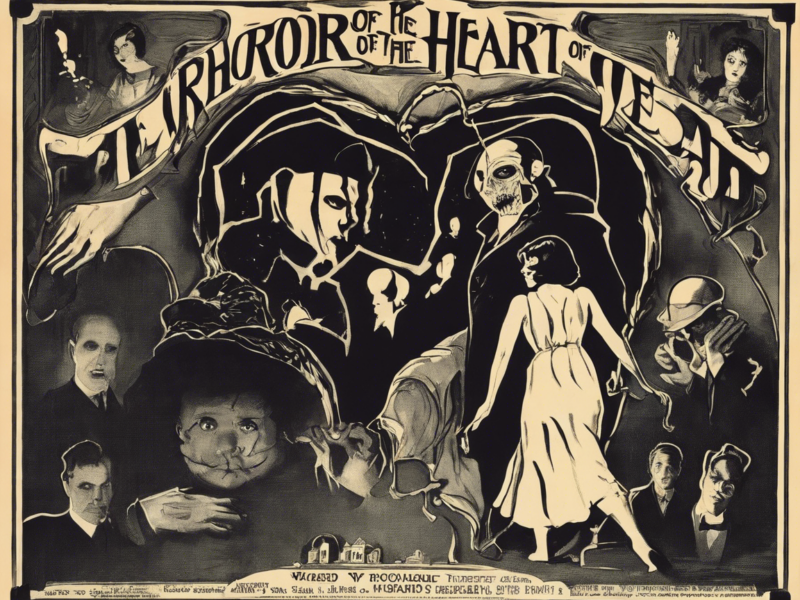In the year 1920, the horror genre experienced a new flourishing period with the release of several iconic films that would go on to shape the genre for decades to come. Silent films were the primary medium for storytelling at this time, and their ability to convey atmosphere and suspense without the need for dialogue created a haunting charm that still captivates audiences today. From classic monsters to psychological thrillers, 1920 had it all for horror fans. Let’s delve into the spooky world of 1920 and explore some of the most notable films and trends that emerged during this decade of terror.
The Silent Era of Horror
Silent films were the epitome of cinematic artistry during the early 20th century, and the horror genre found a perfect home within this medium. The lack of spoken dialogue allowed filmmakers to focus on visual storytelling, relying on expressive acting, atmospheric lighting, and haunting music to create an immersive experience for viewers.
Notable Films
- “The Cabinet of Dr. Caligari” (1920) – Directed by Robert Wiene, this German expressionist film is often cited as the first true horror film. Its twisted sets and disturbing narrative set a new standard for what horror could achieve on screen.
- “The Golem: How He Came into the World” (1920) – Directed by Paul Wegener and Carl Boese, this silent film explores the legend of the Golem, a creature brought to life to protect the Jewish community in Prague. Its surreal imagery and moral themes were groundbreaking for the time.
- “Dr. Jekyll and Mr. Hyde” (1920) – Directed by John S. Robertson and starring John Barrymore, this adaptation of Robert Louis Stevenson’s novella delves into the duality of human nature and the consequences of unleashing one’s dark side.
Classic Monsters and Their Legacy
The 1920s saw the birth of several iconic movie monsters that would become staples of the horror genre. These creatures, ranging from vampires to werewolves to mad scientists, captured the imaginations of audiences and set the stage for the rise of Universal Pictures’ monster universe in the 1930s.
Iconic Characters
- Nosferatu – Although released in 1922, this silent film featuring a vampiric count bore significant influence on the horror genre of the time. Count Orlok’s terrifying appearance and haunting presence left a lasting impact on audiences.
- The Phantom of the Opera – Played by Lon Chaney in the 1925 film adaptation, the disfigured Phantom haunting the Paris Opera House became an icon of horror cinema, blending tragedy with terror in a mesmerizing performance.
- The Monster – Boris Karloff’s portrayal of the Frankenstein Monster in the 1931 film solidified the creature’s status as a cultural icon. However, the character’s roots can be traced back to the silent era, with films like “Frankenstein” (1910) showcasing early interpretations of Mary Shelley’s classic tale.
Psychological Thrillers and Mind Games
In addition to classic monsters, the 1920s also saw a rise in psychological horror films that delved into the inner workings of the human mind. These movies often explored themes of insanity, paranoia, and obsession, challenging audiences to confront the more unsettling aspects of the human psyche.
Mind-Bending Films
- “The Phantom Carriage” (1921) – Directed by and starring Victor Sjöström, this Swedish film follows the tale of a cursed man forced to confront his past on New Year’s Eve. Its haunting visuals and bleak atmosphere made it a standout in psychological horror.
- “The Hands of Orlac” (1924) – Directed by Robert Wiene, this film explores the macabre consequences of a pianist’s hands being replaced with those of a convicted murderer. The sense of dread and uncertainty permeating the story make it a classic of the genre.
- “The Cat and the Canary” (1927) – Directed by Paul Leni, this gothic tale of an inheritance, a haunted mansion, and a potential madman mixes humor with chills in a way that would set the stage for future horror-comedies.
The Legacy of 1920s Horror
The horror films of the 1920s laid the foundation for what would become a thriving genre in the decades to come. Their innovative storytelling, iconic imagery, and impactful performances continue to influence filmmakers and entertain audiences to this day. From the expressionist nightmares of German cinema to the gothic tales of Hollywood, the 1920s were a crucial period in the evolution of horror cinema.
As we look back on these haunting films from a century ago, we can appreciate the timeless appeal of their storytelling and the enduring power of their imagery. The 1920s may have been a decade of change and uncertainty, but they were also a decade of terror that gave birth to some of the most beloved monsters and memorable scares in cinema history.
Frequently Asked Questions (FAQs) About 1920 Horror Films
1. Were all horror films in the 1920s silent?
While silent films dominated the era, there were a few early sound experiments in horror, such as “The Terror” (1928), which featured limited dialogue and sound effects. However, the silent format remained prevalent until the arrival of “Dracula” and “Frankenstein” in 1931.
2. Who were some of the notable actors in 1920s horror films?
Actors like Lon Chaney, Bela Lugosi, and Boris Karloff rose to prominence during this era, becoming synonymous with classic horror characters like The Phantom, Dracula, and Frankenstein’s Monster.
3. What impact did German expressionism have on 1920s horror?
German expressionism, with its emphasis on stylized visuals and symbolic storytelling, greatly influenced the look and feel of many horror films of the time, including “The Cabinet of Dr. Caligari” and “Nosferatu”.
4. Were there any female directors or writers involved in 1920s horror?
While female filmmakers were rare in that era, one notable example is writer and director Lois Weber, who directed several silent films that touched on social issues, including “Suspense” (1913), which had thriller elements.
5. How did the Hays Code impact horror films in the 1920s?
The Hays Code, which imposed censorship guidelines on Hollywood films from the 1930s to the 1960s, did not have a direct impact on 1920s horror films. However, it would later shape the content and themes of horror movies in the Golden Age of Hollywood.
6. What were some common tropes in 1920s horror films?
Themes like mad scientists, haunted houses, masked villains, and mysterious curses were prevalent in 1920s horror films, reflecting the fears and obsessions of society during that period.
7. Did any 1920s horror films inspire remakes or adaptations in later years?
Absolutely! Many of the iconic films from the 1920s, such as “Dr. Jekyll and Mr. Hyde” and “The Phantom of the Opera”, have been remade and reimagined multiple times over the years, showcasing the enduring popularity and influence of these early classics.
8. How did the innovation of special effects impact 1920s horror films?
While special effects were still in their infancy during this era, filmmakers used practical techniques like miniatures, makeup, and optical illusions to create magical worlds and terrifying creatures, setting the stage for the technological advancements that would come later.
9. Were there any notable international horror films in the 1920s?
Yes, several countries produced innovative horror films in the 1920s, including Germany (“The Cabinet of Dr. Caligari”), Sweden (“The Phantom Carriage”), and France (“The Fall of the House of Usher”). These films showcased diverse storytelling and unique cultural perspectives on the horror genre.
10. How can I watch 1920s horror films today?
Many classic silent horror films from the 1920s are public domain and can be found on streaming platforms like YouTube or purchased in DVD collections. Film archives and specialty channels may also screen these historical gems, allowing viewers to experience the early days of horror cinema firsthand.




